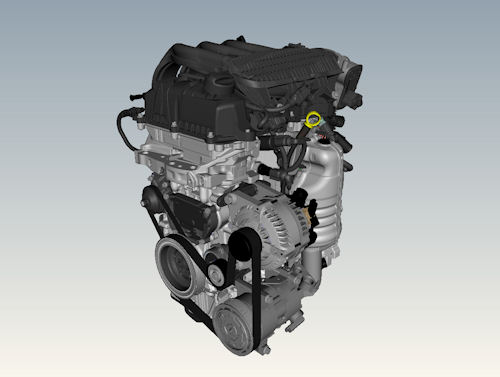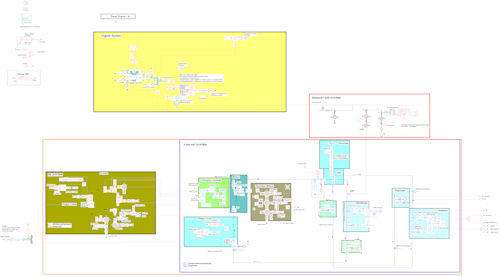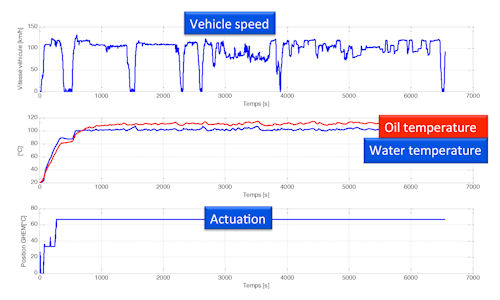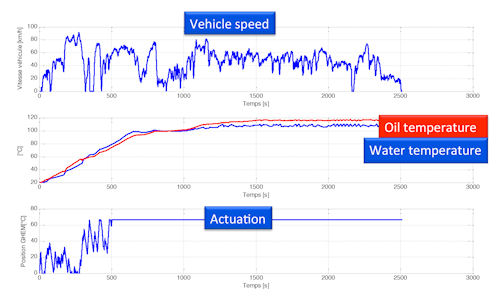Fast App: Pushing the Pedal to Its Mettle
Mechatronic simulation enables PSA Peugeot Citroën to enhance fuel efficiency and reliability of powertrain components.

Latest News
November 14, 2013
Car manufacturers face multiple challenges when designing powertrain architectures. They must reconcile numerous (and sometimes contradictory) requirements to reach the desired level of product quality, pollutant emissions, passenger comfort, fun-to-drive performance, reliability and safety. And they must do all of this while striving to be profitable, shorten the product development cycle and reduce time-to-market.
 Citroën DS5 Hydrid4 combines 200 hp with 88 grams per kilometer of CO2 emissions. |
Powertrain systems are becoming increasingly complex, and include a growing number of actuators, sensors, hybrid traction systems, and electric and electronic components — requiring controls and protection strategies to limit component damage. Developing powertrain thermal management strategies is a major issue for original equipment manufacturers (OEMs), and these strategies are taking more systems into account than ever before, including the internal combustion engine, gearbox, car interior, electric powertrain battery and electronic controls units.
Powertrain thermal management optimization enables car manufacturers to reduce fuel consumption (for example, via warm-up phase acceleration) and carbon dioxide (CO2) emissions. Therefore, it allows the OEMs to meet stringent international standards. It also facilitates appropriate powertrain cooling and passenger thermal comfort by controlling cooling fluid temperature and flow rate in the air heater.
 Peugeot 508 RXH is a “through-the-road” hybrid vehicle with 107 grams per kilometer of CO2 emissions. |
In addition, effective powertrain thermal management maintains an optimal operating temperature for the engine and gearbox, promoting component reliability and fuel efficiency. The thermal management system can adapt to vehicle usage under a variety of conditions, and set temperature thresholds to further help protect powertrain components.
Broad Appeal
PSA Peugeot Citroën addresses powertrain thermal management by using simulation throughout the powertrain component and system design process. Moreover, the simulation approach is applied for validating supplier proposals as well as for powertrain control validation on hardware-in-the-loop (HIL) test benches, and for control pre-calibration.
 PSA Peugeot Citroën s 1.2-liter, three-cylinder gasoline engine. |
In 1995, PSA Peugeot Citroën started using LMS Imagine.Lab AMESim software (AMESim), the mechatronic system simulation platform that is now part of Siemens PLM Software. Prior to the AMESim implementation, the company had been using a variety of tools for powertrain subsystem modeling. That often caused interoperability problems when carrying out global system analysis. That s why a key factor in PSA Peugeot Citroën s decision to adopt AMESim was its broad set of pre-defined and validated component libraries, which are suitable for multi-domain system modeling.
“Without AMESim, it would have been much more difficult to tackle current design challenges,” says Eric Le Dantec, Ph.D., powertrain modeling and simulation expert at PSA Peugeot Citroën. “With a trial-and-error approach, the time required for physical testing would have been too long.”
 The thermal management powertrain system model built using AMESim. Click on the image for a larger version. |
AMESim is used for all design phases, from component sizing to full vehicle integration and validation, without any model compatibility problems, Le Dantec reports. For example, engineers in the PSA Peugeot Citroën powertrain architecture design department are actively using AMESim for coolant and oil circuits design. After that, to carry out complex powertrain thermal management analysis, completed models are plugged together. Then design engineers evaluate the impact of a design choice on the overall system and compare the efficiency of different architectures. By using AMESim, in a matter of minutes they can choose between an electric and mechanical water pump or continuous and controlled flow in water-oil heat exchangers of the engine and gearbox.
PSA Peugeot Citroën, which is known for its best-in-class car handling, is also using AMESim for vehicle dynamics synthesis.
For controls integration work, PSA Peugeot Citroën often performs co-simulation using MATLAB/Simulink. A simplified workflow between AMESim and Simulink was, therefore, also a key point in its decision.
Developing Protective Strategies
PSA Peugeot Citroën has recently extended its simulation approach to the evaluation of the effect of new technologies on powertrain component reliability. The powertrain architecture design department wanted to take into account different usage situations in the powertrain system robustness analysis. Design engineers built an engine thermal management model using AMESim, and carried out co-simulation with MATLAB/Simulink. The use of AMESim enabled engineers to measure the evolution of oil and water temperatures, as well as transient requests of actuation components in different driving conditions.
To assess damage, the reliability-based approach allowed powertrain design engineers to obtain component request histograms so they could understand the constraints that each component faces during its service life. This enabled PSA Peugeot Citroën to size powertrain components and provide suppliers with specifications to meet the durability requirements for the entire system.
Moreover, design engineers implemented protection strategies that account for component damage to protect the engine. These strategies allowed for either reducing the performance request above a certain threshold of component damage, or limiting the duration of the most damaging usage situations. The system simulation approach allowed the powertrain architecture design department to define these protection strategies — and identify potential conflicts between them.
“Real expertise can only emerge from teamwork,” Le Dantec concludes. “That s why it s impossible to carry out the design process effectively without cooperation among internal teams and suppliers. I think that the collaborative aspect will be at the heart of concern to improve design processes. LMS Imagine.Lab SysDM and System Synthesis are consistent with these trends.”
Info
Subscribe to our FREE magazine, FREE email newsletters or both!
Latest News
About the Author
DE’s editors contribute news and new product announcements to Digital Engineering.
Press releases may be sent to them via [email protected].








